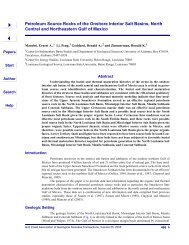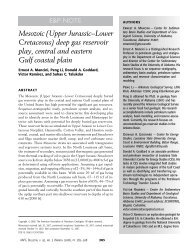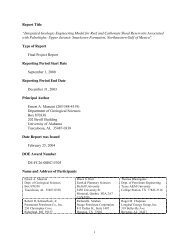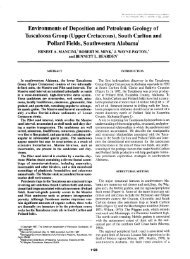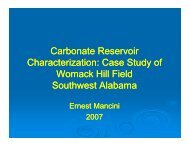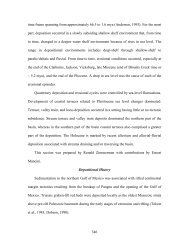Norphlet Formation (Upper Jurassic) - Berg - Hughes Center
Norphlet Formation (Upper Jurassic) - Berg - Hughes Center
Norphlet Formation (Upper Jurassic) - Berg - Hughes Center
Create successful ePaper yourself
Turn your PDF publications into a flip-book with our unique Google optimized e-Paper software.
896 <strong>Norphlet</strong> <strong>Formation</strong> (<strong>Upper</strong> <strong>Jurassic</strong>), Alabama~~^ ESCAMBIAMOBILE 1(^BALDWINFigure 16—Top of <strong>Norphlet</strong> gas-pool structure map for Lower Mobile Bay-Mary Ann field. Mobile Bay. (Published with permissionof Mobil Oil Exploration and Producing Southeast, Inc.)of any significant organic matter. The thermal alterationindices for Smackover carbonates indicate that the thermalhistory for much of southwestern and offshore Alabamawas highly favorable for hydrocarbon generation(Table 1). Assuming an average geothermal gradient of1.3°F (0.72°C) for southwestern and offshore Alabama,<strong>Jurassic</strong> oil generation and migration probably were initiatedwith the deposition of 5,000 to 6,000 ft (1,524 to 1,829m) of overburden. Such a depth of burial for the <strong>Norphlet</strong>-Smackover probably was achieved in the Early Cretaceousfor much of southwestern and offshore Alabama.CONCLUSIONS<strong>Upper</strong> <strong>Jurassic</strong> <strong>Norphlet</strong> paleogeography in southwesternand offshore Alabama was dominated by a broad desertplain, rimmed to the north and east by theAppalachians and to the southwest by a developing shallowsea. The desert plain extended westward into easternand central Mississippi.<strong>Norphlet</strong> conglomerates were deposited in coalescingalluvial fans in proximity to an Appalachian source, andred beds accumulated in distal portions of alluvial fan andwadi systems. Quartz-rich sandstones were deposited asdune and interdune sediments on a broad desert plain. Amarine transgression was initiated during the late phase of<strong>Norphlet</strong> deposition, resulting in the reworking of previouslydeposited <strong>Norphlet</strong> sediments.<strong>Norphlet</strong> hydrocarbon potential in southwestern andoffshore Alabama is excellent, with petroleum traps beingprimarily structural traps involving salt anticlines, faultedsalt anticlines, and extensional fault traps associated withsalt movement. Reservoir rocks consist primarily ofquartz-rich eolian, wadi, and marine sandstones havingprincipally secondary (dissolution) porosity with someintergranular porosity. Smackover algal carbonate mudstoneswere most likely the source for the <strong>Norphlet</strong> hydrocarbons.<strong>Jurassic</strong> oil generation and migration probablywere initiated in the Early Cretaceous, assuming an averagegeothermal gradient of 1.3°F (0.72°C) and an overburdenof 5,000 to 6,000 ft (1,524 to 1,829 m).REFERENCES CITEDAhlbrandt, T. S., and S. G. Fryberger, 1981, Sedimentary features andsignificance of interdune deposits, in Recent and ancient nonmarinedepositional environments: models for exploration: SEPM SpecialPublication 31, p. 293-314.1982, Introduction to eolian deposits, in Sandstone depositionalenvironments: AAPG Memoir 31, p. 11-47.Badon,C. L., 1975, Stratigraphy and petrology of <strong>Jurassic</strong> <strong>Norphlet</strong> <strong>Formation</strong>,Clarke County, Mississippi: AAPG Bulletin, v. 59, p. 377-392.




